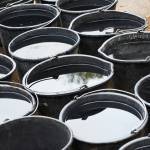Keep Horses Hydrated to Guard Against Impaction Colic

The transition into winter weather means some important management changes for your horse. The pasture that provided a variety of green forage is now sparsely covered with dry, brown dormant plants. The trough that was full of cool water all summer is now offering cold water, slush, or even ice. Finally, the feeding program is likely to change as hay replaces grass, and the concentrate portion of the diet may be modified also in amount or type.
Horse owners have long known that any change in a horse’s management—travel, diet, exercise level, water intake, even the weather—can increase the risk of digestive upset. Change three or four things at once, and the risk for colic goes way up. That’s why it’s important to think about the changing season and take precautions to prevent problems before they show up.
Three factors that have a particular relationship to colic are exercise, diet, and water consumption. Colic is rare in horses that get plenty of exercise, are turned out to pasture where they can graze on fresh forage, and have plenty of fresh water available at all times. With the shift to winter management, these factors all change within a fairly short time. Horses may have more time in the stall with less ridden or free exercise. Even horses that are still turned out may spend idle hours in the run-in shed, hiding from the wind. Hay, with its low moisture content and high amount of dry matter, replaces the horse’s grazing pattern of eating fresh grass more or less constantly. Water consumption may drop sharply if the water source is frozen or offers only very cold water. In some cases, these factors result in lower gut mobility. When ingested material stops moving through the digestive tract, owners begin to see the signs of impaction colic.
Adequate water consumption is possibly the most important factor to prevent impaction. Owners should be sure horses always have access to clean, fresh water that is not too cold. Consumption of hay stimulates thirst, so stalled horses may need more water than what is contained in a single bucket. Water tank heaters and automatic waterers should be checked frequently to be sure they are operating properly. Water doesn’t need to be hot, but horses will drink more if the water temperature isn’t hovering just a degree or two above freezing. For stalled horses, clean and refill buckets frequently, especially for horses that like to dunk their hay or dribble mouthfuls of grain into their water.
Feed clean hay that is at least mediocre quality. Not every horse needs top-grade alfalfa, but most will do well on clean grass or a grass-legume mix. Avoid hay that is overly mature or full of rough, stemmy material.
Encourage exercise by giving the horse as much turnout as possible, preferably with a pasture buddy or two. Even a daily half-hour of hand walking is better than stall confinement for days on end. Light riding, driving, longeing, or even free exercise in an indoor arena will help to keep ingested material moving through the horse’s digestive tract.
Impaction colic usually responds favorably to treatment, but the condition can be quite uncomfortable for the horse and may require several days of treatment at a veterinary clinic. During the transition from fall to winter management, give horses every chance to stay active and hydrated to lower the risk of impaction.








